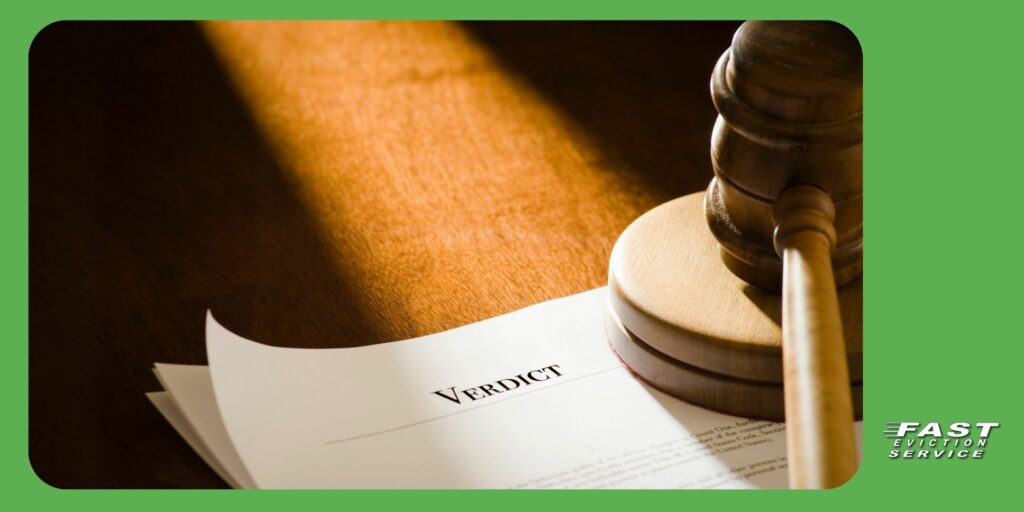Updated 9/4/24
Winning a legal case against a tenant in court is only half the battle for landlords. After receiving a judgment in your favor, the next challenge is figuring out how to collect the awarded money. Unfortunately, just because the court has ruled in your favor doesn’t mean the funds will be handed over automatically. Knowing how to collect a judgment is crucial for any landlord facing this situation. This article will walk you through the steps necessary to ensure that you can collect the amount owed after winning a judgment.

What Does It Mean to Collect a Judgment?
When a court rules in favor of a landlord and issues a judgment against a tenant, it means the tenant is legally obligated to pay a specific amount of money, whether it’s unpaid rent, damages, or legal fees. However, courts do not enforce judgments directly. It is up to the landlord to take steps to collect the judgment from the tenant.
Understanding the different methods available to collect a judgment is essential for making the right decisions after a court victory. These methods include garnishing wages, levying bank accounts, and placing liens on property.
Step 1: Understanding Your Judgment
Before you begin the collection process, you must thoroughly understand the judgment issued by the court. The judgment will specify how much the tenant owes you and may include interest if the debt goes unpaid for an extended period. It’s essential to keep this document safe, as it will be necessary when attempting to collect a judgment.
The next step is determining whether the tenant has the means to pay. Some tenants may lack sufficient income or assets, making collection difficult or impossible. In such cases, it may not be worth pursuing aggressive collection strategies, but in other situations, there are several methods that can help recover the owed money.
Step 2: Garnishing Wages
One of the most effective ways to collect a judgment is through wage garnishment. In this process, a portion of the tenant’s paycheck is automatically deducted and sent to you to satisfy the debt. To initiate wage garnishment, you’ll need to file the necessary paperwork with the court and provide information about the tenant’s employer.
The amount that can be garnished from wages varies by state but is typically capped at 25% of the debtor’s disposable income. Wage garnishment ensures that you regularly receive payments toward the judgment, though it may take time for the full amount to be paid off.
Keep in mind that not all tenants have a stable income or formal employment. If the tenant is self-employed or works under the table, wage garnishment may not be a viable option.
Step 3: Levying Bank Accounts
If wage garnishment is not an option, another way to collect a judgment is by levying the tenant’s bank account. This involves freezing the debtor’s account and withdrawing funds directly to cover the amount owed. To do this, you must obtain a court order and serve it to the tenant’s bank.
Once the account is frozen, the tenant will have limited access to their funds, and you will be able to collect the money in the account up to the amount of the judgment. Bank levies can be an effective way to collect a judgment, especially if the tenant has a substantial balance in their account.
However, this method only works if the tenant has enough funds available in their bank account. Additionally, some states provide protections for certain types of accounts or limit the amount that can be levied, so it’s important to understand the laws in your jurisdiction before pursuing this option.
Step 4: Placing a Lien on Property
If the tenant owns real estate or other valuable property, you can place a lien on these assets as part of your effort to collect a judgment. A lien gives you a legal claim to the property and prevents the tenant from selling or refinancing it without first paying off the debt.
To place a lien, you’ll need to file the appropriate paperwork with the county recorder’s office or another local authority. Once the lien is in place, the tenant may feel pressured to resolve the debt to clear the title on their property.
Liens can be an effective long-term strategy if the tenant has significant assets but is unwilling or unable to pay the judgment upfront. However, it may take time to collect the judgment through this method, as the tenant may not sell the property for years.
Step 5: Seizing Assets
Another method to collect a judgment is to seize the tenant’s assets, such as vehicles, jewelry, or other valuable items. This process, called a writ of execution, allows the sheriff or another law enforcement officer to seize and sell the tenant’s property to satisfy the judgment.
To begin asset seizure, you must file for a writ of execution from the court. Once granted, the writ allows authorities to confiscate assets and auction them off, with the proceeds going toward the amount owed to you.
This method can be useful if the tenant owns valuable assets that can be sold, but it also has its limitations. Not all assets are eligible for seizure, and many states have laws protecting essential items, such as vehicles needed for work or personal items of minimal value.
Step 6: Working with Collection Agencies
If collecting a judgment on your own proves to be too difficult or time-consuming, you can hire a collection agency to pursue the debt on your behalf. Collection agencies specialize in recovering debts and have the resources and expertise needed to track down tenants and collect payments.
However, keep in mind that collection agencies typically charge a percentage of the recovered amount, which means you won’t receive the full judgment. Nevertheless, this option can be beneficial for landlords who want to avoid the hassle of dealing with the collection process themselves.
Step 7: Renewing the Judgment
If you are unable to collect a judgment within a certain time frame, you may need to renew the judgment before it expires. In many states, judgments are valid for 10 years, but this period can vary. Renewing the judgment ensures that you retain the right to collect on it even if the tenant’s financial situation changes in the future.
Renewing a judgment may give you more time to use the methods discussed above, particularly if the tenant’s circumstances improve over time.
Collecting a judgment can be a complex and sometimes lengthy process, but it is crucial for landlords seeking to recover unpaid rent, damages, or other expenses. Knowing the different methods available, from wage garnishment to asset seizure, gives you a range of options to pursue based on the tenant’s financial situation.
While collecting a judgment can require persistence and patience, the payoff is worth it when you recover the money owed to you. Landlords should also familiarize themselves with local laws and consult with an attorney or collection agency to ensure that the process is handled legally and efficiently. Remember, the key to successfully collecting a judgment is taking the right steps and staying informed throughout the process.



